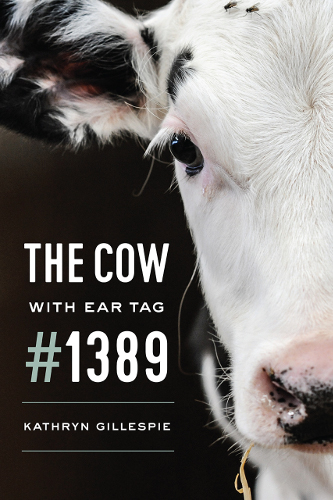 This is a book about farmed animals: about their exploitation and the complex web of factors that serves to normalise this exploitation. Kathryn Gillespie invites us to re-think our relationship to non-human animals and to how their lives have been co-opted for human consumption.
This is a book about farmed animals: about their exploitation and the complex web of factors that serves to normalise this exploitation. Kathryn Gillespie invites us to re-think our relationship to non-human animals and to how their lives have been co-opted for human consumption.
From the outset, she challenges some common assumptions about the dairy industry.
First and foremost, the myth that cows always produce milk.
Just like other mammals, dairy cows only produce milk to feed their children. However, dairy farmers typically separate mothers from their calves within 24 hours of birth, diverting the milk to the food industry and either selling the calves for veal or fattening them up for beef.
The cows continue to be artificially impregnated every year until they are deemed spent, ready for slaughter, typically ending up on a fast food menu.
Gillespie also looks at the ways in which animals are classified in our culture (cats and dogs are ‘pets’, rats are ‘pests’, and cows are ‘food’), noting that how we talk about animals serves to justify our treatment of them.
Instead, she treats each dairy cow as an individual, sentient, emotional being with a personality, immediately raising the question: how can we even begin to know the experience of a member of another species?
The idea of ‘anthropomorphism’ – attributing human characteristics to animals – is key here. It is often criticised on the grounds that ‘cows just can’t be happy or sad like humans’.
However, as Gillespie notes, such a denial is political. If cows do indeed have emotional lives – they are reported to cry for days when their calves are taken away from them – then the dairy industry poses a serious ethical dilemma.
The difficulties Gillespie faced in trying to visit a dairy farm to conduct her research shows how secretive the industry remains.
Chapter by chapter, she takes us from Anselm farm (the only dairy farm that allowed her to visit), to the auction markets (where spent cows are sold to meat buyers), the zoo and the slaughterhouse – vividly describing how each of these human-made structures actively shapes the lives of millions of farmed animals.
Gillespie also digs into the challenges faced by workers in the dairy industry, including the trauma, the low wages and the lack of security.
In one section, she describes a scene in a cull market auction, where old and unproductive dairy cows are sold before being taken to the slaughterhouse. Cow #1389 limps into the ring, eyed by meat buyers who instantly know her value is next to nought: her udders hang red with mastitis (the painful inflammation of the udders usually caused by the milking process) and her back leg cannot bear any weight.
Suddenly, this cow collapses onto the floor, her mouth foaming with saliva, her breathing laboured while the bidders jeer. Yet the cow with ear tag #1389 is only one cow out of the millions that go through the system each day.
The narrative skilfully uses the destiny of a few individual cows to explore the bigger social and economic factors at play.
Most telling is Gillespie’s analysis of the dairy industry as a capitalist market: not only are the cows commodified – constantly ‘managed and made more efficient’ – but they are actual ‘commodified beings whose life is wholly shaped and determined by… [their] commodification.’
In the last chapters of the book, Gillespie explores how the dairy industry is kept afloat: from advertising (‘Drink milk!’) to political lobbyists, as well as the lack of animal rights in US law and the ways in which we are taught to think and speak about animals at school.
For readers with prior knowledge of the topic, the book provides an illuminating framework for further thought, especially in Gillespie’s discussion of animal sanctuaries.
Recounting her visits to these, she explores their structures, their ethos and the challenges in creating a space that actively takes into account the animals’ needs and emotions. These sanctuaries ask the important question: how can we live with animals in the least hierarchical (and least violent) way?
I very much recommend this determined and engaging analysis of the dairy industry.
Topics: Animal rights


